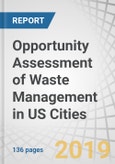Increasing focus on waste recycling and energy generation and adoption of IoT-based smart waste management systems to drive the market
Seattle, a major city in the US, has increased its overall recycling rate for 13 consecutive years (2003–2016). In 2016, Seattle recycled 58.8% of its municipal solid waste with an annual increase of 0.8%. The city aims to achieve an overall 70% recycling rate by 2022. Key factors driving the waste management assessment in the select major US cities include an increasing focus on the collection of waste materials and transportation to recycling facilities, sorting material type and selling them to manufacturers to make new products, state governments’ increasing focus on waste recycling and energy generation, and increasing adoption of smart waste management systems.
Increasing focus on waste recycling to provide growth opportunities
Population explosion, coupled with improved lifestyle, results in increased generation of solid wastes in urban as well as rural areas. In US cities, there is a marked distinction between the solid waste from urban and rural areas. However, due to increased urbanization, fast adoption of ‘use & throw concept’ and equally fast communication the gap between the two is diminishing. The solid waste from rural areas is more of a biodegradable nature and the same from urban areas contains more non-biodegradable components, such as plastics and packaging. Recycling organic materials which include food and compostable paper is the biggest opportunity to reduce trash and focus on recycling initiatives. Organics make up about one-quarter of overall trash, and few people are taking part in organics recycling programs yet. The increasing focus on vendors toward organic waste in the region is expected to provide growth opportunities for the market vendors.
Increasing adoption of IoT-based smart waste management systems to improve assessment capabilities
Internet and its applications have become an integral part and essential tools in smart waste management to increase the overall efficiency and reduce operational costs. Owing to increasing demand and necessity, the implementation of smart waste management using IoT assures the collection of the garbage soon as the garbage level reaches its maximum level. The system will thus provide accurate reports, increasing the efficiency of the system. The real-time monitoring of the garbage level with the help of sensors and wireless communication reduces the total number of trips required of garbage collecting vehicles and the total expenditure associated with the garbage collection. Thus, the dustbins will be cleared as and when filled, giving way to better infrastructure and increased hygiene.
In-depth interviews were conducted with the Chief Executive Officers (CEOs), marketing directors, other innovation and technology directors, and executives from various key organizations operating in the waste management market to figure out assessment opportunities for key cities in the US.
- By Company: Tier 1 – 20%, Tier 2 – 55%, and Tier 3 – 25%
- By Designation: C-Level – 50%, Director Level – 25%, and Others – 25%
- By Region: North America – 60%, Europe – 20%, APAC – 10%, and RoW – 10%
Major vendors offering waste management systems include Bigbelly, Inc. (US), Compology (US), OnePlus Systems (US), Ecube Labs (South Korea), Waste Management Inc. (US), Republic Services Inc. (US), Covanta Holding Corporation (US), Recology (US), Athens Services (US), and Bin-e (Poland). The study includes an in-depth competitive analysis of the key players in the waste management market, along with their projects and investments, recent developments, and key market strategies. Market players have embraced different strategies to bring innovative solutions to expand their global presence and increase their market shares. The vendors have focused on IoT-based sensors to deploy innovative waste recycling and energy generation systems.
Research coverage
The waste management opportunity assessment primarily focuses on key cities in the US. Other regions where the study is conducted include Sweden and China.
Key Benefits of the report
- The report would help the market leaders/new entrants in the market with the information on the closest approximations of the revenue numbers for the overall waste management market and its subsegments.
- The report would help stakeholders understand the competitive landscape and gain insights to better position their businesses and plan suitable go-to-market strategies.
- It would also help stakeholders understand the pulse of the market and provide them with information on the key market drivers, restraints, challenges, and opportunities.
Table of Contents
Companies Mentioned
- Athens Services (US)
- Bigbelly Inc. (US)
- Bin-e (Poland)
- Compology (US)
- Covanta Holding Corporation (US)
- Ecube Labs (South Korea)
- OnePlus Systems (US)
- Recology (US)
- Republic Services Inc. (US)
- Waste Management Inc. (US)








